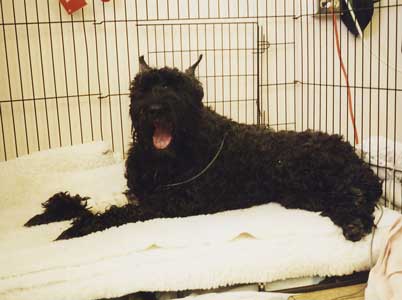Jose was dumped off loose into the parking lot at the Santa Clara Humane Society shelter. His owners couldn't be bothered to walk him up to the door (which is attended 24/7) so he could enter safely instead of risking being hit by a car. He had growled at another rescuer who therefore declined to take him, so I was called to rescue him. I noticed that his "fall" of hair was so profuse that it completely covered his eyes, virtually blindfolding him. this sort of "hair blindfold" can cause a dog to behave as if he were actually blind or visually impaired and can make him act as if he had some kind of behavior or temperament problem, notably as if he were shy , fearful, or fearfully aggressive. First thing I did when we got home was to take a scissors and give him a "hair-ectomy" so he could see. And I named him "Jose," not because the Santa Clara Humane is located in San Jose, but rather so he could have his own theme song, beginning "Jose can you see?"
Because he was not neutered, I put him out in my kennel run, intending to introduce him to my own dogs more gradually. Next day I did a bit of training and grooming and started to get to know him. The following morning (Sunday) when I looked out my window to check on him , I noticed he was panting badly thought the day was so far just moderately warm. I went out for a closer look and saw that when he tried to standup , his rear end was seriously out of whack, partly crippled. This is panic time! I ran back into the house and phoned the U C Davis School of Veterinary Medicine's Veterinary Medical Teaching Hospital (VMTH) on the Emergency line to bring him in as an emergency case. He was able to hobble to the car and I helped him get in. We got there and almost immediately found he was running a dangerously high temperature, just below the level at which brain damage begins and which becomes life threatening. He was admitted into the Intesive Care Unit, where they started him on fluids and antibiotics and various measures to get his fever down into a safer level. At this point the emergency intake vet thought he had in infection in the intervertebral discs in his spine. Later that day they were able to get spinal x-rays, which showed damage to his vertebrae as well, and do blood cultures which showed systemic infection. We debated whether or not to do surgery that night or to try to get the massive infection under control first, and decided the latter seemed the better choice, especially as there was some doubt as to what exactly was the problem. Over the next two days his neurological condition deteriorated, and his rear end became totally paralyzed. The radiologists and the neurologists determined that he had a long-standing infection in the bones of his spine and that some of the vertebrae had now more or less disintegrated. Surgery was technically possible but the concensus of the entire neurology department was that the chances that he would ever be able to use his hind end, ever be able to walk , ever be able to control his urination and defecation, were very very slight, maybe 1 chance in 20, and meanwhile he was suffering badly and recovery from surgery would involve months of misery for him (and I might add for whoever took care of him, namely me). One could not touch him withut muzzling him , because his distress was so bad in spite of the best pain-killing medicines.
This photograph was taken a few minutes before we gave him the only real mercy available, the Sacrament of Euthanasia.
Not every rescue story has a happy ending.
(And his former owners, who must have known for some time that he was seriously ill , had better hope that their Afterlife will be designed by Dante Alighieri rather than by me !!!)

